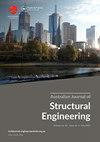Ternary combined industrial wastes for non-fired brick
IF 1.3
Q4 ENGINEERING, CIVIL
Australian Journal of Structural Engineering
Pub Date : 2022-02-22
DOI:10.1080/13287982.2022.2038406
引用次数: 2
Abstract
ABSTRACT The demand for bricks in South Asia is increasing significantly due to growth in the construction sector. Bricks produced using traditional firing technique and fertile clay contribute significantly to some of the worst air pollution in the world. Therefore, the utilisation of other environment-friendly alternative to conventional bricks is considered an urgent need to conserve a clean environment and help in saving its fertile soil. This research aimed to explore geopolymerisation technique with ternary combined industrial waste/by-products as binders including high volume Ladle Furnace Slag (LFS), Fly ash and Ground Granulated Blast Furnace Slag (GGBS) to produce non-fired and clay-free brick alternatives. The first two byproducts are locally produced in the related iron and power industry while GGBS are being imported by the cement industry. The results indicated that all the prepared samples conform to the minimum compressive strength requirement of 20.7 MPa and maximum water absorption rate of 17% for common brick with severe weathering as per ASTM C62. This highly promising performance pronounced the use of locally available high volume LFS and other industrial waste/by-products materials in non-fired building block production to achieve a cleaner, environmental-friendly sustainable society as well as a sustainable route for industrial waste management.未烧结砖的三元复合工业废料
由于建筑行业的增长,南亚地区对砖的需求正在显著增加。使用传统烧制技术生产的砖和肥沃的粘土是造成世界上一些最严重空气污染的重要原因。因此,使用其他环境友好型砖替代传统砖被认为是迫切需要,以保持清洁的环境,并有助于保存其肥沃的土壤。本研究旨在探索用三元组合工业废物/副产品作为粘合剂的地聚合技术,包括大量的钢包炉渣(LFS)、粉煤灰和磨粒高炉渣(GGBS),以生产非烧制和无粘土砖替代品。前两种副产品由当地相关的钢铁和电力工业生产,而GGBS则由水泥工业进口。结果表明,所制备的试样均符合ASTM C62对普通风化砖最小抗压强度20.7 MPa和最大吸水率17%的要求。这一极具前景的表现表明,在非燃烧砌块生产中使用当地可获得的大量废铁和其他工业废物/副产品材料,以实现更清洁、环境友好的可持续社会,以及可持续的工业废物管理途径。
本文章由计算机程序翻译,如有差异,请以英文原文为准。
求助全文
约1分钟内获得全文
求助全文
来源期刊

Australian Journal of Structural Engineering
ENGINEERING, CIVIL-
CiteScore
2.50
自引率
0.00%
发文量
31
期刊介绍:
The Australian Journal of Structural Engineering (AJSE) is published under the auspices of the Structural College Board of Engineers Australia. It fulfils part of the Board''s mission for Continuing Professional Development. The journal also offers a means for exchange and interaction of scientific and professional issues and technical developments. The journal is open to members and non-members of Engineers Australia. Original papers on research and development (Technical Papers) and professional matters and achievements (Professional Papers) in all areas relevant to the science, art and practice of structural engineering are considered for possible publication. All papers and technical notes are peer-reviewed. The fundamental criterion for acceptance for publication is the intellectual and professional value of the contribution. Occasionally, papers previously published in essentially the same form elsewhere may be considered for publication. In this case acknowledgement to prior publication must be included in a footnote on page one of the manuscript. These papers are peer-reviewed as new submissions. The length of acceptable contributions typically should not exceed 4,000 to 5,000 word equivalents. Longer manuscripts may be considered at the discretion of the Editor. Technical Notes typically should not exceed about 1,000 word equivalents. Discussions on a Paper or Note published in the AJSE are welcomed. Discussions must address significant matters related to the content of a Paper or Technical Note and may include supplementary and critical comments and questions regarding content.
 求助内容:
求助内容: 应助结果提醒方式:
应助结果提醒方式:


